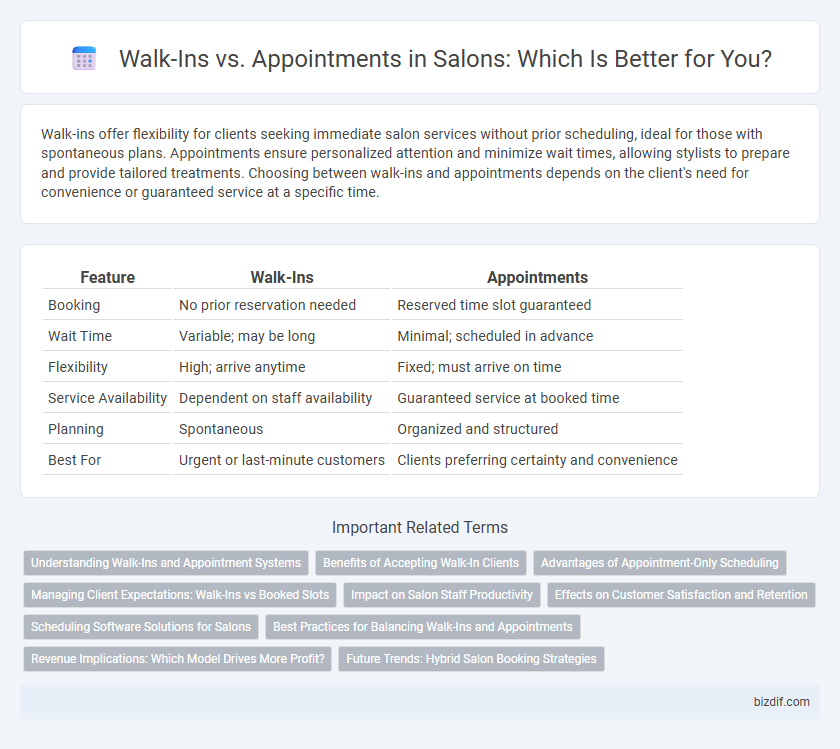Walk-ins offer flexibility for clients seeking immediate salon services without prior scheduling, ideal for those with spontaneous plans. Appointments ensure personalized attention and minimize wait times, allowing stylists to prepare and provide tailored treatments. Choosing between walk-ins and appointments depends on the client's need for convenience or guaranteed service at a specific time.
Table of Comparison
| Feature | Walk-Ins | Appointments |
|---|---|---|
| Booking | No prior reservation needed | Reserved time slot guaranteed |
| Wait Time | Variable; may be long | Minimal; scheduled in advance |
| Flexibility | High; arrive anytime | Fixed; must arrive on time |
| Service Availability | Dependent on staff availability | Guaranteed service at booked time |
| Planning | Spontaneous | Organized and structured |
| Best For | Urgent or last-minute customers | Clients preferring certainty and convenience |
Understanding Walk-Ins and Appointment Systems
Walk-ins offer clients spontaneous access to salon services without prior scheduling, allowing flexibility for both customers and stylists. Appointment systems organize client visits through pre-booked time slots, enhancing workflow efficiency and reducing wait times. Understanding the balance between walk-ins and appointments helps salons optimize service delivery and maximize client satisfaction.
Benefits of Accepting Walk-In Clients
Accepting walk-in clients increases salon revenue by filling unexpected gaps in the schedule and attracting spontaneous customers seeking immediate service. Walk-ins enhance customer satisfaction by offering flexible options for busy clients who cannot plan appointments in advance. This approach also boosts salon exposure and encourages repeat visits through convenient, accessible service without prior commitment.
Advantages of Appointment-Only Scheduling
Appointment-only scheduling ensures personalized attention by allocating dedicated time slots for each client, reducing wait times and improving service quality. This system enhances operational efficiency, allowing salons to better manage staff workload and inventory based on confirmed bookings. Clients benefit from guaranteed availability and customized consultations, fostering higher satisfaction and loyalty.
Managing Client Expectations: Walk-Ins vs Booked Slots
Managing client expectations in salons involves clearly communicating the differences between walk-ins and booked appointments to minimize wait times and ensure smooth service flow. Walk-in clients should be informed about potential delays during peak hours, while booked appointments guarantee a specific time slot, providing a more predictable and efficient experience. Salons that balance walk-in flexibility with appointment precision optimize client satisfaction and operational efficiency.
Impact on Salon Staff Productivity
Walk-ins create unpredictable workloads that can disrupt salon staff productivity by causing idle periods followed by high-intensity work bursts. Scheduled appointments allow for optimized time management, enabling staff to prepare and allocate appropriate resources efficiently. Balancing walk-ins with appointments ensures steady workflow, improving overall service quality and employee performance.
Effects on Customer Satisfaction and Retention
Walk-ins offer spontaneous convenience that appeals to customers seeking immediate service, boosting satisfaction through reduced wait times and flexibility. Appointments enhance personalized attention and predictability, allowing salons to manage time efficiently and foster deeper client relationships. Balancing walk-ins and appointments optimizes customer retention by combining accessibility with tailored experiences that meet diverse client preferences.
Scheduling Software Solutions for Salons
Scheduling software solutions for salons enhance efficiency by managing both walk-ins and appointments seamlessly, reducing wait times and optimizing staff allocation. These platforms offer real-time updates and automated reminders, improving customer experience and minimizing no-shows. Integration with client management systems allows salons to track preferences and purchase history, facilitating personalized service and targeted marketing.
Best Practices for Balancing Walk-Ins and Appointments
Balancing walk-ins and appointments in a salon requires clear communication of availability and flexible scheduling systems to optimize client flow. Implementing designated time slots for walk-ins alongside pre-booked sessions ensures efficient use of staff and resources while minimizing wait times. Utilizing real-time booking software allows salons to dynamically adjust capacity, enhancing customer satisfaction and operational productivity.
Revenue Implications: Which Model Drives More Profit?
Appointments often generate higher revenue per client by allowing salons to efficiently manage schedules and reduce idle time, leading to increased productivity and upselling opportunities. Walk-ins can boost volume during slow periods, attracting spontaneous customers but may result in unpredictable downtime and staffing inefficiencies. Salons that balance both models strategically tend to optimize profit by maximizing client flow while maintaining service quality.
Future Trends: Hybrid Salon Booking Strategies
Hybrid salon booking strategies blend walk-ins with appointments, offering clients flexible scheduling options that cater to diverse preferences. Predictive analytics and AI-powered systems optimize time slots, reducing wait times while maximizing stylist stylist productivity. Salons adopting these hybrid models are poised to enhance customer satisfaction and operational efficiency, aligning with evolving consumer demands.
Walk-Ins vs Appointments Infographic

 bizdif.com
bizdif.com